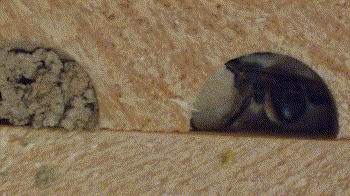
The Bees fill these holes from the back all the way forward to the front. In the cover animation, a female can be seen laying larva at the end of the tunnel. Her face and body covered in pollen as she works hard during peak season to build as many homes as possible. Probably the final cell before she caps off the end with mud and moves onto a new hole. This can be seen at 1:05 and again at 9:38 She will repeat this building many depending on how far of a flight she needs to travel from flower to the home. I try to provide them with many flowering plants and trees within 100 yards of them.
At 5:45 a Mason Bee can be seen collecting wood fibers from the holes. Since I only roughly sanded down these tunnels there are little flecks of wood attached to the tunnels. Searching for pieces she can break off with her mandibles. She hangs around for a little awhile before deciding to take flight, maybe off to the hole she is working on building homes in.
Seeing the mud walls of different colors makes me think these Bees are quite diverse in where they collect mud. As I see tan colored mud, brown and even the red Georgia clay mud thats well known around where I live. Being high in iron it makes the dirt rust colored. The Bees seem quite happy with it as a building material.
At 11:41 a Mason Bee can be seen laying fresh mud down, it was still wet in appearance as it has not dried yet.
In Part 5 we will see the flight path of the Bees as I pull the camera away from the home. Its obvious how busy the homes get. In the next part I will also move their homes. As we have had problems with Luci the dog sticking her face inside the Bee house when walking by it. She will try to eat the Bees, and I dont want her to get stung. Has not happened yet but would rather be proactive. These Mason Bees are very gentle and I have yet to have any aggression issues towards humans. No stings yet and they just seem to want to be busy building homes and not much else.
LBRY Video Link
During the few months while these Bees were out and from February through April I brought my tripod outside along with my Lumix GH3 camera, I put my Olympus MSC ED M. 60mm Macro lens on it and just let it record them working hard at their homes.
In this series I will be using a Shure VP83 LensHopper external microphone to capture the sounds of the Bees. A high pitched buzzing can be heard occasionally coming from inside the homes when the Bees are shaking off the pollen they collected. And the video is recorded at 60 FPS for smooth footage of the Bees flying and moving around. Using LBRY as my video platform, the video I rendered is what you get in playback, so there should be little to no loss when viewing.
Two kinds of Mason Bees can be seen entering and leaving the homes. The most easy way to tell which is which is their butts. One has a plain black abdomen (Osmia cornuta) also known as a European Orchard Bee. And the other has a yellow fuzzy abdomen (Osmia leaiana) also known as a Orange-vented Mason Bee.
Previous Parts:
https://peakd.com/hive-123046/@solominer/a-closer-look-at-solitary-bees-part-1
https://peakd.com/hive-123046/@solominer/a-closer-look-at-solitary-bees-part-2
https://peakd.com/hive-123046/@solominer/a-closer-look-at-solitary-bees-part-3-a-fight-breaks-out
Addresses below to help me buy better camera equipment and support me to travel to locations to do photo and video and overall great blogs in new places. I would be happy to list some of the contributors in my posts for donations that help me along the way.
| Coin | Address |
|---|---|
 BTC: BTC: | bc1qhfmvd2gywg4fvrgy2kkkkyqta0g86whkt7j8r7 |
 LTC: LTC: | ltc1qdyzm5cwgt8e2373prx67yye6y9ewk0l8jf3ys9 |
 DASH: DASH: | XkSqR5DxQL3wy4kNbjqDbgbMYNih3a7ZcM |
 ETH: ETH: | 0x045f409dAe14338669730078201888636B047DC3 |
 DOGE: DOGE: | DSoekC21AKSZHAcV9vqR8yYefrh8XcX92Z |
 ZEN: ZEN: | znW9mh62WDSCeBXxnVLCETMx59Ho446HJgq |
Honey project...good job dear...
Downvoting a post can decrease pending rewards and make it less visible. Common reasons:
Submit
No honey is produced by solitary bees.
Downvoting a post can decrease pending rewards and make it less visible. Common reasons:
Submit
I appreciate your great activeness
Downvoting a post can decrease pending rewards and make it less visible. Common reasons:
Submit